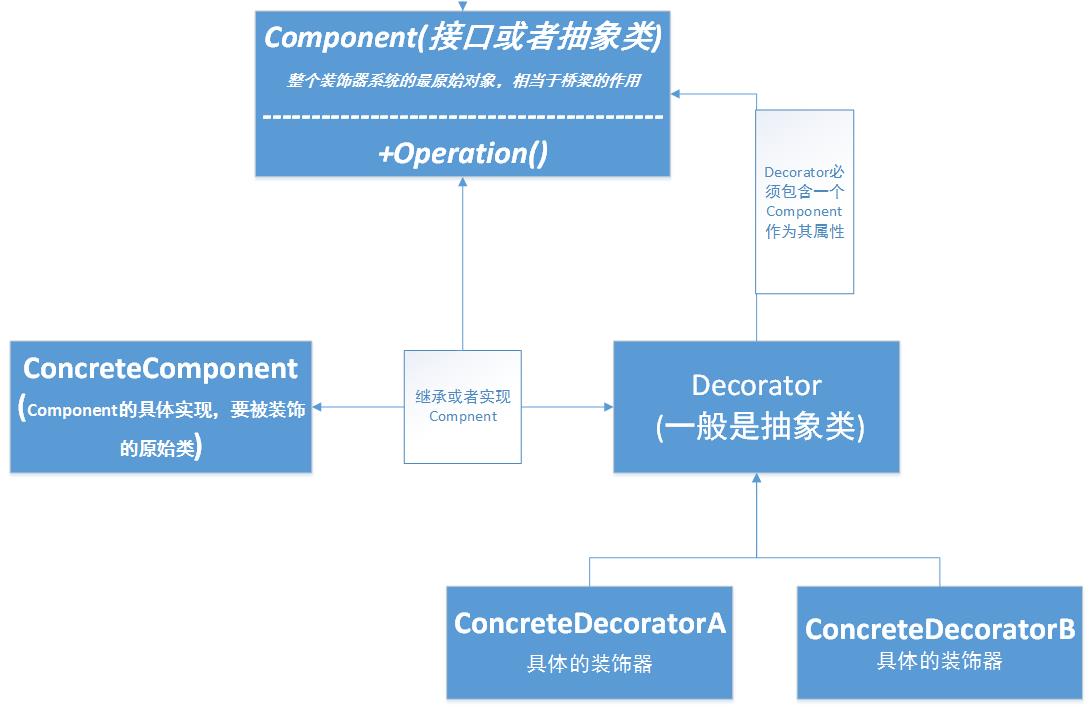java之装饰器模式
Posted 朱洪昌
tags:
篇首语:本文由小常识网(cha138.com)小编为大家整理,主要介绍了java之装饰器模式相关的知识,希望对你有一定的参考价值。
Decorator Pattern(装饰器模式),定义:Attach additional responsibilities to an object dynamically. Decorators provide a flexible alternative to subclassing for extending functionality.(动态地给一个对象添加一些额外的职责。就增加功能来说,装饰模式相比生成子类更为灵活)
装饰器的通用视图:

上图四个角色解释一下:
1.Component抽象构件:
Component是一个接口或者一个抽象类,就是定义我们最核心的对象,也就是最原始的对象,最高层次的抽象,统一整个装饰器系统,用于装饰器之间沟通的桥梁,就像II/O流中的InputStream,OutputStream一样
2.ConcreteComponent具体构件
ConcreteComponent是最核心,最原始,最基本的接口或者抽象类的实现,你要装饰的就是它,装饰的源头,你装饰的最底层,就像I/O流一样,这就直接跟底层打交道的节点流,就比如FileInputStream
3.Decorator 装饰角色
一般是一个抽象类,实现接口或者抽象方法,它并不一定有抽象方法,但在它的属性里必须有一个private变量指向Component抽象构件,一般是用构造器初始化。就像I/O流中的FilterInputStream
4.ConcreteDecoratorA,ConcreteDecoratorB具体的装饰器角色,这就是要将我们之间建的最核心,最原始,最基础的东西装饰成东西或者其他的东西,就像I/O中的BufferedInputStream,DataInputStream等。
下面给出一个简单的例子:
1 package decorator; 2 //抽象构件 3 public interface Component 4 { 5 void operation(); 6 } 7 //具体的抽象构件的实现 8 public class ConcreteComponent implements Component 9 { 10 11 /** { @inheritDoc } */ 12 @Override 13 public void operation() 14 { 15 System.out.println("我是ConcreteComponent,是最原始的实现类,我处于最底层"); 16 } 17 18 } 19 //抽象装饰器 20 public abstract class Decorator implements Component 21 { 22 private Component component; 23 24 /** 25 * @param component 26 */ 27 public Decorator(Component component) 28 { 29 this.component = component; 30 } 31 32 /** { @inheritDoc } */ 33 @Override 34 public void operation() 35 { 36 component.operation(); 37 } 38 } 39 //具体装饰器A 40 public class ConcreteDecoratorA extends Decorator 41 { 42 43 /** 44 * @param component 45 */ 46 public ConcreteDecoratorA(Component component) 47 { 48 super(component); 49 } 50 51 public void methodA() 52 { 53 System.out.println("我是ConcreteDecoratorA,添加的新功能"); 54 } 55 56 /** { @inheritDoc } */ 57 @Override 58 public void operation() 59 { 60 methodA(); 61 super.operation(); 62 System.out.println("ConcreteDecoratorA的operation执行完毕"); 63 } 64 65 } 66 //具体装饰器B 67 public class ConcreteDecoratorB extends Decorator 68 { 69 70 /** 71 * @param component 72 */ 73 public ConcreteDecoratorB(Component component) 74 { 75 super(component); 76 } 77 78 public void methodB() 79 { 80 System.out.println("我是ConcreteDecoratorB,添加的新功能"); 81 } 82 83 /** { @inheritDoc } */ 84 @Override 85 public void operation() 86 { 87 methodB(); 88 super.operation(); 89 System.out.println("ConcreteDecoratorB的operation执行完毕"); 90 } 91 92 } 93 //测试类 94 public class Demo 95 { 96 public static void main(String[] args) 97 { 98 Component component = new ConcreteComponent(); 99 100 ConcreteDecoratorB decoratorB = new ConcreteDecoratorB(new ConcreteDecoratorA(component)); 101 102 decoratorB.operation(); 103 } 104 }
上边的例子是用最原始的类使用接口实现的,同样也可以采用抽象类实现,在此不再贴代码了,测试类的大致代码走向,即实际的装饰流程

装饰器模式的优缺点:
优点:
1.相比与静态的继承,装饰器模式正如它定义的,那样可以动态的给一个对象添加额外的职责, 显得更加灵活。静态继承的情况下,如果要添加其他的功能就需要添加新的子类实现功能,然后相互之间继承,以达到一个组合的功能,对于每一个要添加的功能都要,新建类,显得特别麻烦,也使得系统越来越复杂,而对于装饰器来说,为一个特定的Component提供多种不同的Decorator,对于一些要达成的功能,相互组合就可以达成目的
2.装饰类和被装饰类可以独立发展,而不会相互耦合
3.装饰模式是继承关系的一个替代方案。我们看装饰类Decorator,不管装饰多少层,返回的对象还是Component,实现的还是is-a的关系
缺点:
对于装饰模式记住一点就足够了:多层的装饰是比较复杂的。为什么会复杂呢?你想想看,就像剥洋葱一样,你剥到了最后才发现是最里层的装饰出现了问题,想象一下工作量吧,因此,尽量减少装饰类的数量,以便降低系统的复杂度
与装饰难解难分的I/O系统
以上是关于java之装饰器模式的主要内容,如果未能解决你的问题,请参考以下文章